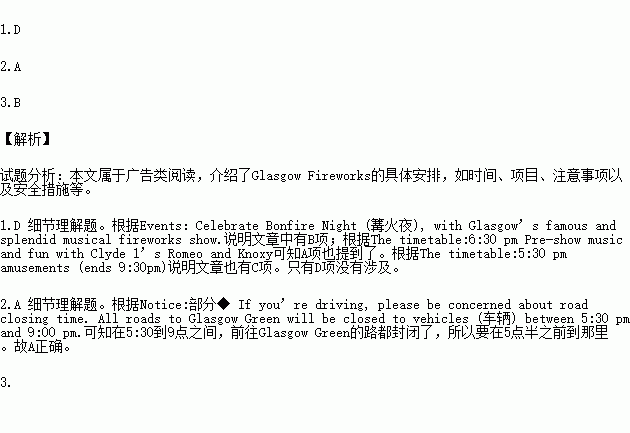题目内容
Glasgow Fireworks
25th July 2012
Location: Glasgow Green
Tickets: This event is free, and no ticket is required
Events:Celebrate Bonfire Night (篝火夜), with Glasgow’s famous and splendid musical fireworks show. The night is not just about fireworks though; there will be pre-show music and fun with Clyde 1’s Romeo and Knoxy, amusements and food and drink booths. Enough to make sure that everyone is entertained!
The timetable:
5:30 pm amusements (ends 9:30pm)
6:30 pm Pre-show music and fun with Clyde 1’s Romeo and Knoxy
7:30 pm Fireworks show begins
Notice:
◆ Entry is free, and it is usually very busy. Make sure you get there early for a good view (unless you’re 7 feet tall).
◆ You should enter Glasgow Green from the west end of the park. There is no other public entry.
◆ If you’re driving, please be concerned about road closing time. All roads to Glasgow Green will be closed to vehicles (车辆) between 5:30 pm and 9:00 pm.
◆ Join our mailing list to stay up to date with all the latest information on www. Glasgow Green. com. Should it be put off or called off, we will keep you informed as soon as possible!
For Your Safety
◆ Do not bring fireworks, sparklers, alcohol or pets to the Glasgow Green Fireworks.
◆ Follow the directions of staff and police.
◆ Dress properly – We live in Glasgow and there is always a good chance we will get rubbish weather!
1.Which of the following isn’t mentioned in the text?
A. Pre-show music. B. Fireworks show.
C. Amusements. D. Movies.
2.If you go to the show by car, you have to get there _______.
A. before 5:30 pm B. after 9:30 pm
C. around 6:30 pm D. between 5:30 pm and 9:00 pm
3.How does the organizer keep you informed of the latest information?
A. By radio. B. By E-mail. C. By phone. D. By post.

